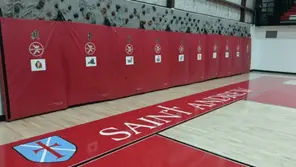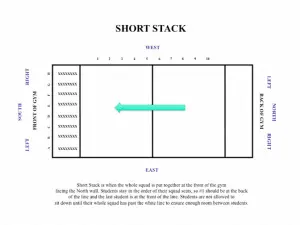
How to Teach Personal Space
- Many teachers use the “helicopters” method. This is when you stand spread out and extend your arms out to the side and rotate your body back and forth. While doing this, you shouldn’t be able to touch anyone or anything.
- Scatter like Ants is a great key phrase that we use in our gym when I want students to have their own personal space.
- When I call out “Scatter like Ants,” the students randomly run, not following or chasing one another and keeping personal space by not bumping into or pushing another student. They do this until I give a count down… “5, 4, 3, 2, 1, Freeze, Hands on Top.” (That means stop!) Then I have them check their space. Are their feet in our given general space? Like within the basketball court for example. Are they able to do the “Helicopter” without touching?
- Another way to teach personal space is with hoops. Have students move around the gym carrying a hoop with the goal of not bumping into one another. You can even have your students exercise within the space of the hoop.
- In our gym, we like to build our games. Starting at the most basic level and then adding another element each round. Here is a video of a great game, Spaceship Tag, using hula hoops to learn personal space.
Spaceship Tag
Level 1:
Each student has his/her own hoop to use as a spaceship. Students travel around the gym doing different locomotor skills, trying not to bump into one another. If two spaceships crash into one another, both students sit down in their hoop until the teacher taps them on the head.
Level 2:
Adding on, when two spaceships bump into one another, both students have to do 10 exercises of their choice to get back in.
Level 3:
Now it’s time to add in the taggers, aka Aliens. Choose 2-4 Aliens to use pool noodles to tag the spaceships. This time there is no returning into the game. Once the Alien tags or you crash into another spaceship, you have to do exercises until the round is over.
Level 4:
Building onto the game, let’s add Astronauts. Choose 4 students to be the Astronauts to help the spaceships get back into the game by raising the hoop up, so they can fly away again.
Level 5:
Our last build of the game is allowing the students to put their spaceship in motion by hula hooping while they walk. If their spaceship hits the ground, they are out until an Astronaut helps them.
How to Teach General Space

Here are some tips that I have in place to help manage our general space.
- Labeling directional signs: North, South, East, West
- Left and Right signs on each wall
- Letters and Numbers for squad lines
- Student Formations
Squad Lines/Home Base

Every spot is called a Home Base, and depending on grade level, these can be assigned spots or student picked daily. Labeling your gym is important and also helps with class management because it makes directions easier.
“Line up all the scooters along the south wall.”
“I need four lines facing the West wall and even with Letters A, C, E, G, GO!”
Formations
Student formations have been one of the most helpful tools in managing PE space. A labeled gym it makes it really easy to use student formations to manage our time and space. Here is a closer look at the different student formations we use to help manage our class. (Click on the image for a larger version)










One Response
What do you use to label your gym? I can’t find any stickers to do that.